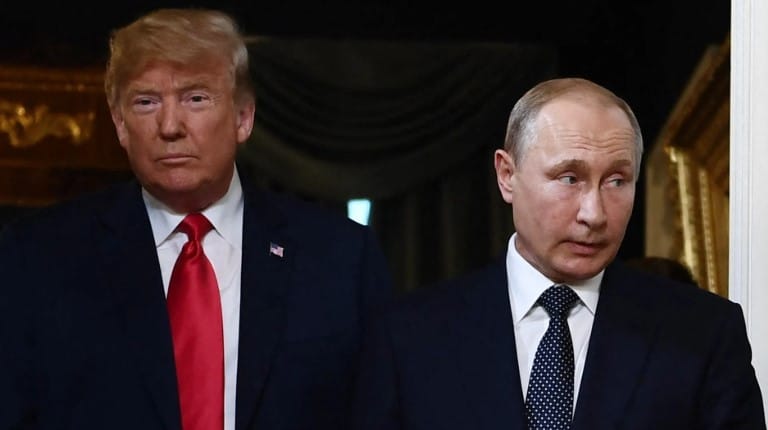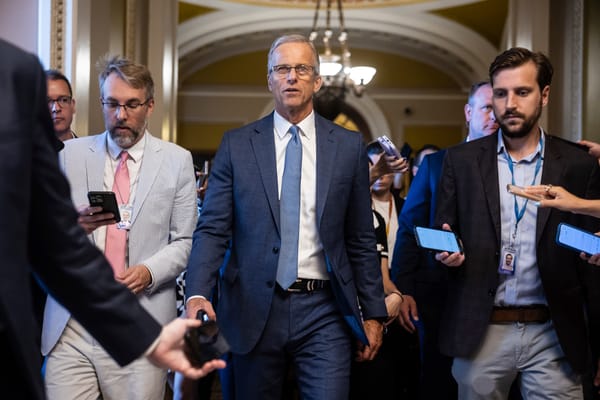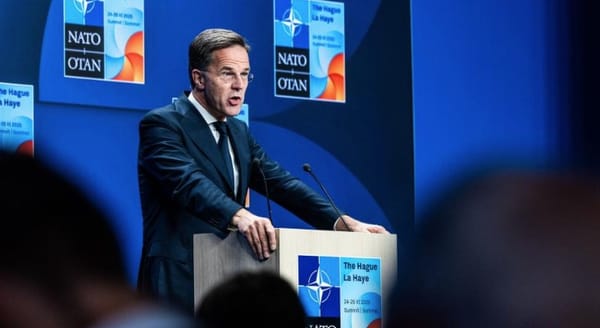Trump's Ukraine Weapons Gambit: A Hawkish Pivot That Could Reshape Russia-Ukraine Conflict

President Donald Trump's July 14, 2025 announcement of a major weapons package for Ukraine, combined with his threat of punitive tariffs against Russia, represents one of the most significant policy reversals of his presidency. This dramatic shift from his previous stance on Ukraine aid signals a fundamental transformation in his approach to the Russia-Ukraine conflict and could have far-reaching implications for the war's trajectory.
The Genesis of Trump's Strategic Pivot
Trump's frustration with Russian President Vladimir Putin reached a breaking point following their July 3, 2025 phone call, where Putin made it clear he intended to escalate the conflict rather than negotiate a ceasefire[1][2]. During that conversation, Putin indicated he planned to make "a renewed push to occupy territory up to the administrative lines of the Ukrainian regions in which Russia has a significant foothold" over the following 60 days[3]. This revelation apparently shattered Trump's expectations of a quick diplomatic resolution.
The president's growing exasperation became evident in his public statements. "I'm disappointed in President Putin because I thought we would have had a deal two months ago, but it doesn't seem to get there," Trump declared during his meeting with NATO Secretary General Mark Rutte[4]. His irritation was further reflected in his characterization of Putin's duplicitous behavior: "He talks nice and then bombs everybody in the evening"[5][6].
This diplomatic breakdown represented a stark departure from Trump's earlier optimistic assessments of his relationship with Putin. The president had entered office with confidence that his personal rapport with the Russian leader would facilitate a swift resolution to the conflict. When that assumption proved incorrect, Trump's approach underwent a fundamental transformation.
The $10 Billion Weapons Package: Structure and Scope
The centerpiece of Trump's new strategy involves a novel arrangement whereby the United States will manufacture and sell weapons to NATO allies, who will then transfer them to Ukraine. This mechanism allows the U.S. to maintain its support for Ukraine while ensuring European nations bear the financial burden. "We're going to make top-of-the-line weapons, and they'll be sent to NATO," Trump explained during the announcement[4:1].
The initial tranche of this program involves approximately $10 billion in weapons sales to NATO allies[7]. The arrangement includes participation from multiple European nations, with Germany, Finland, Denmark, Canada, Norway, Sweden, the United Kingdom, and the Netherlands all committed to purchasing American-made military equipment for Ukraine[8][9].
The weapons package encompasses a comprehensive array of defensive and offensive systems. Most prominently, it includes Patriot air defense systems, which Ukraine has desperately needed to counter Russia's intensified aerial bombardment campaign[4:2][10]. Trump indicated that some Patriot systems would arrive "within days" through a swap arrangement where countries currently possessing Patriots would transfer them to Ukraine and receive newer American systems as replacements[7:1].
Beyond air defense, the package reportedly includes long-range missiles capable of striking targets deep within Russian territory, potentially including Moscow[3:1]. This represents a significant escalation in the type of weaponry being provided to Ukraine, moving beyond purely defensive systems to include offensive capabilities that could fundamentally alter the conflict's dynamics.
The Patriot System: Ukraine's Shield Against Russian Missiles
The Patriot missile system represents one of the most critical components of the weapons package. These advanced air defense systems are Ukraine's primary means of intercepting Russia's sophisticated ballistic missiles, including the hypersonic Kinzhal missiles that Russia has touted as virtually unstoppable[11]. Ukraine currently operates six fully operational Patriot batteries, with components provided by the United States, Germany, and the Netherlands[12].
The effectiveness of these systems in Ukraine has been remarkable. The Patriot has successfully intercepted a wide range of Russian weaponry, including Su-34 fighters at distances of nearly 100 miles and missiles as far as 130 miles away[13]. Perhaps most significantly, Ukrainian Patriot systems have repeatedly shot down Russian Kinzhal missiles, which can reach speeds up to Mach 10[13:1]. This capability has proven crucial as Russia continues to launch hundreds of drones and dozens of cruise and ballistic missiles within hours[11:1].
The strategic importance of expanding Ukraine's Patriot arsenal cannot be overstated. Russia launched 10 times more drones and missiles in June 2025 than in the same month the previous year, resulting in the highest monthly civilian casualties of the past three years, with 232 people killed and 1,343 wounded[9:1]. The additional Patriot systems promised by Trump could significantly enhance Ukraine's ability to protect its civilian population and critical infrastructure from these relentless attacks.
The Secondary Tariffs Ultimatum: Economic Warfare Against Russia
Trump's threat to impose 100% "secondary tariffs" on countries that continue trading with Russia represents a potentially devastating economic weapon. Unlike traditional tariffs that target the primary trading partner, secondary tariffs are designed to isolate a country by penalizing third parties who continue commercial relationships with the targeted nation[14][9:2].
The 50-day ultimatum Trump established creates a clear deadline for Putin to accept a ceasefire or face severe economic consequences. "We're going to be doing secondary tariffs if we don't have a deal in 50 days. It's very simple and they'll be at 100%," Trump declared[4:3]. This mechanism would particularly impact major purchasers of Russian energy, including China, India, Brazil, and Turkey[15].
The threat carries significant weight because it targets Russia's remaining economic lifelines. With direct U.S.-Russia trade having collapsed by over 90% since 2021 to just $3.5 billion in 2024[16], the real economic pressure lies in cutting off Russia's access to global markets through its remaining trading partners. Secondary tariffs would force these countries to choose between continued commerce with Russia or access to the massive American market.
Congressional support for even more aggressive measures adds credibility to Trump's threat. Senator Lindsey Graham has proposed legislation that would authorize 500% tariffs on Russian trading partners, making Trump's 100% figure appear relatively moderate[17][18]. This Congressional backing suggests that if Trump's current approach fails, even more severe measures could follow.
NATO's Financial Commitment: The 5% GDP Target
The weapons package announcement builds upon the historic NATO commitment to increase defense spending to 5% of GDP by 2035, agreed upon at the June 2025 summit in The Hague[19]. This represents more than a doubling of the previous 2% target and demonstrates the alliance's recognition of the severity of the Russian threat.
The 5% target is structured as 3.5% for core defense spending and 1.5% for defense-related infrastructure, cybersecurity, and other security-related investments[19:1][20]. This framework allows for significant flexibility in how nations meet their obligations while ensuring substantial increases in military capabilities.
For the United States, this commitment provides leverage to ensure that European allies shoulder a greater share of the financial burden for Ukraine's defense. Trump has consistently argued that America has contributed disproportionately to Ukraine's defense, with the U.S. having provided approximately $350 billion in various forms of assistance since the war began[4:4]. The new NATO arrangement effectively shifts much of the ongoing financial responsibility to European nations while maintaining American industrial benefits through weapons sales.
The Human Cost: Casualties and Consequences
The urgency behind Trump's policy shift becomes clearer when examining the staggering human cost of the conflict. According to the Center for Strategic and International Studies, Russia has sustained approximately 950,000 casualties, with as many as 250,000 dead[21][22]. Ukrainian casualties are estimated at nearly 400,000, with between 60,000 and 100,000 killed[21:1][22:1].
These figures represent an unprecedented level of carnage for a modern conflict. The daily casualty rate for Russian forces has averaged around 1,000 soldiers per day, making the Ukraine war 25 times deadlier than the Chechen conflict and 35 times more deadly than the Soviet war in Afghanistan[21:2]. The sheer scale of these losses underscores the war's brutal nature and the imperative for decisive action.
Civilian casualties have also mounted dramatically. The UN has confirmed over 13,000 civilian deaths and more than 32,000 wounded[23], though the actual figures are believed to be significantly higher. The targeting of civilian infrastructure, including hospitals, schools, and residential areas, has created a humanitarian crisis that has displaced millions of Ukrainians.
Economic Devastation and Reconstruction Challenges
The economic implications of the conflict extend far beyond immediate military costs. The World Bank, United Nations, and European Commission estimate that Ukraine's reconstruction and recovery will require $524 billion over the next decade[24][25]. This figure represents approximately 2.8 times Ukraine's estimated 2024 GDP and reflects the comprehensive destruction of the country's infrastructure.
The damage assessment reveals the systematic nature of Russia's assault on Ukrainian society. Housing accounts for $84 billion of the reconstruction needs, with 13% of Ukraine's total housing stock damaged or destroyed, affecting more than 2.5 million households[24:1]. Transport infrastructure requires $78 billion in reconstruction, while energy and mining need $68 billion[24:2].
The targeting of Ukraine's energy infrastructure has been particularly devastating, with a 70% increase in damaged or destroyed assets including power generation, transmission, and distribution systems[24:3]. This systematic destruction of civilian infrastructure represents a deliberate strategy to break Ukrainian morale and capacity for resistance.
The Geopolitical Implications of Trump's Reversal
Trump's policy reversal carries profound implications for the broader geopolitical landscape. His willingness to provide offensive weapons to Ukraine signals a fundamental shift from his previous position of limiting aid to defensive systems. This change suggests that the Trump administration now views the conflict through a more traditional lens of great power competition rather than as a regional dispute to be quickly resolved through negotiation.
The secondary tariffs threat represents a particularly significant escalation because it directly challenges China's position as Russia's primary economic lifeline. Chinese purchases of Russian energy and other commodities have been crucial to sustaining Russia's war effort. By threatening to penalize these transactions, Trump is essentially forcing Beijing to choose between its relationship with Moscow and its access to American markets.
This approach aligns with broader trends in U.S. foreign policy toward more aggressive economic statecraft. The use of secondary sanctions and tariffs as tools of coercion has become increasingly common, and Trump's threat against Russian trading partners represents a significant expansion of this approach.
The Timing and Strategic Calculations
The timing of Trump's announcement is strategically significant. The 50-day ultimatum creates pressure on Putin to make a decision before the onset of winter, when energy concerns typically favor Russia's position. It also provides sufficient time for the initial weapons shipments to reach Ukraine and potentially alter the battlefield dynamics.
The decision to announce the policy alongside NATO Secretary General Mark Rutte reinforces the multilateral nature of the effort and provides political cover for what represents a significant escalation in Western support for Ukraine. Rutte's enthusiastic endorsement of the plan, calling it "really big"[8:1], helps legitimize the policy shift and demonstrates alliance unity.
The announcement also comes at a time when Russia appears to be preparing for a renewed offensive. Putin's indication during the July 3 call that he intended to escalate the conflict suggests that diplomatic solutions remain elusive. Trump's response indicates a recognition that military pressure, rather than diplomatic engagement, may be the only effective means of changing Putin's calculus.
Domestic Political Implications
Trump's policy reversal carries significant domestic political risks. His base has generally supported his "America First" approach and skepticism of foreign military commitments. The decision to provide billions of dollars in weapons to Ukraine, even if paid for by European allies, represents a departure from his previous stance and could face criticism from isolationist Republicans.
However, the structure of the deal may help mitigate domestic opposition. By ensuring that European allies pay for the weapons while American companies benefit from the sales, Trump can argue that the arrangement serves American economic interests. The emphasis on NATO burden-sharing also aligns with his longstanding criticism of allies who fail to meet their defense spending obligations.
The secondary tariffs threat may prove more popular domestically, as it positions Trump as taking a tough stance against both Russia and countries that continue to support the Russian war effort. This approach allows him to appear strong on foreign policy while avoiding direct American military involvement.
Challenges and Limitations
Despite its ambitious scope, Trump's new approach faces several significant challenges. The effectiveness of the secondary tariffs depends on the willingness of major Russian trading partners to comply rather than seek alternative arrangements. Countries like China and India may be reluctant to abandon profitable relationships with Russia, particularly if they can develop workarounds to minimize the impact of American sanctions.
The weapons delivery timeline also presents logistical challenges. While Trump promised that some Patriot systems would arrive "within days"[7:2], the more complex aspects of the weapons package will require time to implement. The training requirements for Ukrainian forces on new systems and the integration of offensive weapons into Ukraine's military strategy will take months to achieve full effectiveness.
There are also questions about the sustainability of the arrangement. The 5% GDP defense spending target represents a massive financial commitment for European nations, many of which are already struggling with high debt levels. Countries like Spain have already negotiated opt-outs from the full 5% commitment[26], suggesting that maintaining alliance unity on financing may prove challenging.
The Path Forward: Implications for Conflict Resolution
Trump's policy shift fundamentally alters the dynamics of potential peace negotiations. By providing Ukraine with enhanced defensive capabilities and offensive weapons, the announcement strengthens Kyiv's negotiating position while simultaneously increasing pressure on Moscow through economic threats.
The combination of military and economic pressure creates a more complex strategic environment for Putin. The prospect of facing more capable Ukrainian forces equipped with advanced American weapons, combined with the potential loss of crucial trading relationships, may force a reassessment of Russia's strategic objectives.
However, the escalatory nature of the approach also carries risks. The provision of long-range offensive weapons to Ukraine could prompt Russian retaliation against NATO countries or lead to further escalation of the conflict. The secondary tariffs threat, while economically powerful, could also prompt counter-responses from targeted countries or lead to the development of alternative trading mechanisms that bypass American financial systems.
Conclusion: A Defining Moment
Trump's July 14, 2025 announcement represents a defining moment in both his presidency and the Russia-Ukraine conflict. The decision to provide billions of dollars in weapons to Ukraine while threatening punitive economic measures against Russia marks a fundamental shift from his previous approach and demonstrates the failure of his initial diplomatic strategy.
The policy reversal reflects the harsh realities of dealing with Putin's Russia and the limitations of personal diplomacy in resolving complex international conflicts. Trump's initial confidence that his relationship with Putin would facilitate a quick resolution has given way to a more traditional approach emphasizing military strength and economic pressure.
The success of this new strategy will depend on numerous factors, including the effectiveness of the weapons in changing battlefield dynamics, the willingness of European allies to sustain their financial commitments, and the ability of secondary tariffs to alter the behavior of Russian trading partners. Most critically, it will depend on whether the combination of military and economic pressure can convince Putin that the costs of continuing the war outweigh the potential benefits.
Regardless of the ultimate outcome, Trump's announcement represents a significant escalation in Western support for Ukraine and a recognition that the conflict has become a defining test of the post-Cold War international order. The decision to provide offensive weapons and threaten secondary sanctions signals that the United States is prepared to use its full economic and military power to shape the conflict's outcome.
The implications extend far beyond Ukraine, potentially reshaping relationships with China, India, and other major powers while testing the unity and resolve of the NATO alliance. As the 50-day ultimatum approaches, the world will watch to see whether Trump's gamble pays off or whether it leads to further escalation of an already devastating conflict.
https://www.newsweek.com/donald-trump-putin-call-russia-revealed-2094508 ↩︎
https://www.politico.com/news/2025/07/03/trump-putin-ukraine-00439974 ↩︎
https://www.axios.com/2025/07/14/trump-ukraine-weapons-missiles-russia ↩︎ ↩︎
https://nypost.com/2025/07/14/world-news/trump-vows-billions-of-dollars-in-weapons-for-ukraine-100-tariffs-on-russia-if-no-peace-in-50-days/ ↩︎ ↩︎ ↩︎ ↩︎ ↩︎
https://www.newsweek.com/trump-missiles-patriots-ukraine-2098457 ↩︎
https://thehill.com/homenews/administration/5399283-trump-ukraine-patriot-munitions-putin/ ↩︎
https://kyivindependent.com/some-patriot-systems-to-arrive-in-ukraine-within-days-trump-says/ ↩︎ ↩︎ ↩︎
https://www.foxnews.com/world/trump-rutte-announce-really-big-nato-arms-package-amid-new-50-day-deadline-putin ↩︎ ↩︎
https://www.pbs.org/newshour/world/trump-threatens-to-impose-tariffs-on-russia-if-they-dont-end-ukraine-war-within-50-days ↩︎ ↩︎ ↩︎
https://time.com/7302158/trump-tariffs-putin-ukraine-russia-war-nato-weapons/ ↩︎
https://united24media.com/war-in-ukraine/what-would-a-halt-in-patriot-missile-deliveries-mean-for-ukraine-6393 ↩︎ ↩︎
https://aoav.org.uk/2025/qa-the-patriot-air-defense-system-in-ukraine-a-briefing-note/ ↩︎
https://www.defensenews.com/land/2024/04/09/how-patriot-proved-itself-in-ukraine-and-secured-a-fresh-future/ ↩︎ ↩︎
https://www.cbsnews.com/news/trump-tariffs-russia-ukraine-deal-to-end-war/ ↩︎
https://www.cnbc.com/2025/07/14/trump-trade-russia-ukraine.html ↩︎
https://www.riotimesonline.com/trumps-100-tariff-threat-can-the-u-s-squeeze-russia-with-almost-no-trade-left/ ↩︎
https://thehill.com/newsletters/1230-report/5400050-trump-russia-tariffs-texas-fema-camp-mystic-jeffrey-epstein-controversy-investigation-maga/ ↩︎
https://www.cnbc.com/2025/06/25/nato-allies-agree-to-higher-5percent-defense-spending-target.html ↩︎ ↩︎
https://www.reuters.com/business/aerospace-defense/what-is-natos-new-5-defence-spending-target-2025-06-23/ ↩︎
https://www.cnn.com/2025/06/04/europe/russia-war-casualties-1-million-ukraine-intl ↩︎ ↩︎ ↩︎
https://www.nytimes.com/2025/06/03/us/politics/russia-ukraine-troop-casualties.html ↩︎ ↩︎
https://en.wikipedia.org/wiki/Casualties_of_the_Russo-Ukrainian_War ↩︎
https://www.aljazeera.com/news/2025/2/25/ukraine-reconstruction-costs-cross-half-trillion-dollar-mark-report ↩︎ ↩︎ ↩︎ ↩︎
https://www.worldbank.org/en/news/press-release/2025/02/25/updated-ukraine-recovery-and-reconstruction-needs-assessment-released ↩︎
https://www.dw.com/en/can-debt-laden-nato-members-spend-billions-more-on-defense/a-73235846 ↩︎




